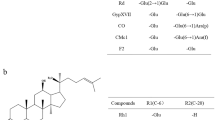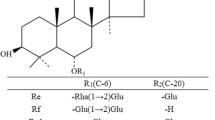Abstract
The thermostable β-glucosidase gene from Thermotoga petrophila DSM 13995 was cloned and overexpressed in Escherichia coli. The activity of the recombinant β-glucosidase was 21 U/mL in the LB medium. Recombinant β-glucosidase was purified, and its molecular weight was approximately 81 kDa. The optimal activity was at pH 5.0 and 90 °C, and the thermostability of the enzyme was improved by Ca2+. The β-glucosidase had high selectivity for cleaving the outer and inner glucopyranosyl moieties at the C-20 carbon of ginsenoside Rb1, which produced the pharmacologically active minor ginsenoside 20(S)-Rg3. In a reaction at 90 °C and pH 5.0, 10 g/L of ginsenoside Rb1 was transformed into 6.93 g/L of Rg3 within 90 min, with a corresponding molar conversion of 97.9 %, and Rg3 productivity of 4620 mg/L/h. This study is the first report of a GH3-family enzyme that used Ca2+ to improve its thermostability, and it is the first report on the high substrate concentration bioconversion of ginsenoside Rb1 to ginsenoside 20(S)-Rg3 by using thermostable β-glucosidase under high temperature.







Similar content being viewed by others
References
Andrews SR, Taylor EJ, Pell G, Vincent F, Ducros VM-A, Davies GJ et al (2004) The use of forced protein evolution to investigate and improve stability of family 10 xylanases the production of Ca2 + -independent stable xylanases. J Biol Chem 279:54369–54379
Attele AS, Wu JA, Yuan C-S (1999) Ginseng pharmacology: multiple constituents and multiple actions. Biochem Pharmacol 58:1685–1693
Ausubel FM, Brent R, Kingston RE, Moore DD, Seidman J, Smith JA et al (2002) Short protocols in molecular biology: a compendium of methods from current protocols in molecular biology. Wiley, New York
Bae E-A, Han MJ, Choo M-K, Park S-Y, Kim D-H (2002) Metabolism of 20 (S)-and 20 (R)-ginsenoside Rg3 by human intestinal bacteria and its relation to in vitro biological activities. Biol Pharm Bull 25:58
Chang KH, Jo MN, Kim K-T, Paik H-D (2014) Evaluation of glucosidases of Aspergillus niger strain comparing with other glucosidases in transformation of ginsenoside Rb1 to ginsenosides Rg3. J Ginseng Res 38:47–51
Cheng L-Q, Na JR, Bang MH, Kim MK, Yang D-C (2008) Conversion of major ginsenoside Rb1 to 20 (S)-ginsenoside Rg3 by Microbacterium sp. GS514. Phytochemistry 69:218–224
Dion M, Fourage L, Hallet JN, Colas B (1999) Cloning and expression of a beta-glycosidase gene from Thermus thermophilus. Sequence and biochemical characterization of the encoded enzyme. Glycoconj J 16:27–37
Gabelsberger J, Liebl W, Schleifer K-H (1993) Purification and properties of recombinant β-glucosidase of the hyperthermophilic bacterium Thermotoga maritima. Appl Microbiol Biotechnol 40:44–52
Gillis CN (1997) Panax ginseng pharmacology: a nitric oxide link? Biochem Pharmacol 54:1–8
Haakana H, Miettinen-Oinonen A, Joutsjoki V, Mäntylä A, Suominen P, Vehmaanperä J (2004) Cloning of cellulase genes from Melanocarpus albomyces and their efficient expression in Trichoderma reesei. Enzym Microb Technol 34:159–167
Han B, Park M, Han Y, Woo L, Sankawa U, Yahara S et al (1982) Degradation of ginseng saponins under mild acidic conditions. Planta Med 44:146–149
Keum Y-S, Park K-K, Lee J-M, Chun K-S, Park JH, Lee SK et al (2000) Antioxidant and anti-tumor promoting activities of the methanol extract of heat-processed ginseng. Cancer Lett 150:41–48
Kim C, Choi K, Kim S, Ko S, Sung H, Lee Y (1998) Controls of the hydrolysis of ginseng saponins by neutralization of organic acids in red ginseng extract preparations. J Ginseng Res 22:205–210
Kim Y-S, Yeom S-J, Oh D-K (2011) Characterization of a GH3 family β-glucosidase from Dictyoglomus turgidum and its application to the hydrolysis of isoflavone glycosides in spent coffee grounds. J Agric Food Chem 59:11812–11818
Larkin M, Blackshields G, Brown N, Chenna R, McGettigan PA, McWilliam H et al (2007) Clustal W and Clustal X version 2.0. Bioinformatics 23:2947–2948
Lee HU, Bae EA, Han MJ, Kim DH (2005) Hepatoprotective effect of 20(S)-ginsenosides Rg3 and its metabolite 20(S)-ginsenoside Rh2 on tert-butyl hydroperoxide-induced liver injury. Biol Pharm Bull 28:1992–1994
Mochizuki M, Yoo YC, Matsuzawa K, Sato K, Saiki I, TONo-oKA S et al (1995) Inhibitory effect of tumor metastasis in mice by saponins, ginsenoside-Rb2, 20 (R)-and 20 (S)-ginsenoside-Rg3, of red ginseng. Biol Pharm Bull 18:1197–1202
Ni J, Xin Y, Wang X, Shi B, Chen D, Tian K et al (2005) Effect of 20 (S)-ginsenoside Rg3 combined with cytotoxic agents on sarcoma 180 of mice. Ji Lin Da Xue Xue Bao (Yi Xue Ban) 31:705–708
Noh K-H, Oh D-K (2009) Production of the rare ginsenosides compound K, compound Y, and compound Mc by a thermostable beta-glycosidase from Sulfolobus acidocaldarius. Biol Pharm Bull 32:1830–1835
Noh K-H, Son J-W, Kim H-J, Oh D-K (2009) Ginsenoside compound K production from ginseng root extract by a thermostable beta-glycosidase from Sulfolobus solfataricus. Biosci Biotechnol Biochem 73:316–321
Park MW, Ha J, Chung SH (2008) 20 (S)-ginsenoside Rg3 enhances glucose-stimulated insulin secretion and activates AMPK. Biol Pharm Bull 31:748–751
Park TH, Choi KW, Park CS, Lee SB, Kang HY, Shon KJ et al (2005) Substrate specificity and transglycosylation catalyzed by a thermostable beta-glucosidase from marine hyperthermophile Thermotoga neapolitana. Appl Microbiol Biotechnol 69:411–422
Parry NJ, Beever DE, Owen E, Vandenberghe I, Van Beeumen J, Bhat MK (2001) Biochemical characterization and mechanism of action of a thermostable beta-glucosidase purified from Thermoascus aurantiacus. Biochem J 353:117–127
Pei J, Pang Q, Zhao L, Fan S, Shi H (2012) Thermoanaerobacterium thermosaccharolyticum β-glucosidase: a glucose-tolerant enzyme with high specific activity for cellobiose. Biotechnol Biofuels 5:1–10
Quan L-H, Min J-W, Yang D-U, Kim Y-J, Yang D-C (2012) Enzymatic biotransformation of ginsenoside Rb1 to 20 (S)-Rg3 by recombinant β-glucosidase from Microbacterium esteraromaticum. Appl Microbiol Biotechnol 94:377–384
Rojas A, Arola L, Romeu A (1995) beta-Glucosidase families revealed by computer analysis of protein sequences. Biochem Mol Biol Int 35:1223–1231
Sambrook J, Fritsch EF, Maniatis T (1989) Molecular cloning. Cold Spring Harbor Laboratory Press, New York
Sevastsyanovich YR, Alfasi SN, Cole JA (2010) Sense and nonsense from a systems biology approach to microbial recombinant protein production. Biotechnol Appl Biochem 55:9–28
Shao W, Wiegel J (1992) Purification and characterization of a thermostable beta-xylosidase from Thermoanaerobacter ethanolicus. J Bazcteriol 174:5848–5853
Shi H, Zhang Y, Li X, Huang Y, Wang L, Wang Y et al (2013) A novel highly thermostable xylanase stimulated by Ca 2 + from Thermotoga thermarum: cloning, expression and characterization. Biotechnol Biofuels 6:26
Shin K-C, Lee H-J, Oh D-K (2014) Substrate specificity of β-glucosidase from Gordonia terrae for ginsenosides and its application in the production of ginsenosides Rg 3, Rg 2, and Rh 1 from ginseng root extract. J Biosci Bioeng
Studier FW (2005) Protein production by auto-induction in high-density shaking cultures. Protein Expr Purif 41:207–234
Sumida T, Sueyoshi N, Ito M (2002) Molecular Cloning and Characterization of a Novel Glucocerebrosidase of Paenibacillus sp. TS12. J Biochem 132:237–243
Sun B-S, Gu L-J, Fang Z-M, C-y Wang, Wang Z, Lee M-R et al (2009) Simultaneous quantification of 19 ginsenosides in black ginseng developed from Panax ginseng by HPLC–ELSD. J Pharm Biomed Anal 50:15–22
Takahata Y, Nishijima M, Hoaki T, Maruyama T (2001) Thermotoga petrophila sp. nov. and Thermotoga naphthophila sp. nov., two hyperthermophilic bacteria from the Kubiki oil reservoir in Niigata, Japan. Int J Syst Evol Microbiol 51:1901–1909
Thongpoo P, McKee LS, Araújo AC, Kongsaeree PT, Brumer H (2013) Identification of the acid/base catalyst of a glycoside hydrolase family 3 (GH3) β-glucosidase from Aspergillus niger ASKU28. Biochimica et Biophysica Acta (BBA) - General Subjects 1830:2739–49
Tian J, Fu F, Geng M, Jiang Y, Yang J, Jiang W et al (2005) Neuroprotective effect of 20(S)-ginsenoside Rg3 on cerebral ischemia in rats. Neurosci Lett 374:92–97
Turner P, Pramhed A, Kanders E, Hedström M, Karlsson EN, Logan DT (2007) Expression, purification, crystallization and preliminary X-ray diffraction analysis of Thermotoga neapolitana β-glucosidase B. Acta Crystallogr Sect F 63:802–806
Wu J, Zhong J-J (1999) Production of ginseng and its bioactive components in plant cell culture: current technological and applied aspects. J Biotechnol 68:89–99
Yoshida E, Hidaka M, Fushinobu S, Koyanagi T, Minami H, Tamaki H et al (2009) Purification, crystallization and preliminary X-ray analysis of beta-glucosidase from Kluyveromyces marxianus NBRC1777. Acta Crystallogr, Sect F: Struct Biol Cryst Commun 65:1190–1192
Zhao L, Xie J, Zhang X, Cao F, Pei J (2013) Overexpression and characterization of a glucose-tolerant β-glucosidase from Thermotoga thermarum DSM 5069T with high catalytic efficiency of ginsenoside Rb1 to Rd. J Mol Catal B Enzym 95:62–69
Zou Z-Z, Yu H-L, Li C-X, Zhou X-W, Hayashi C, Sun J et al (2012) A new thermostable β-glucosidase mined from Dictyoglomus thermophilum: properties and performance in octyl glucoside synthesis at high temperatures. Biores Technol 118:425–430
Acknowledgments
This work was supported by the 11th Six Talents Peak Project of Jiangsu Province (Grant No. 2014-JY-011), the Natural Science Foundation of Jiangsu Higher Education Institutions (Grant No. 12KJB220001), the Natural Science Foundation of Jiangsu Province of China (Grant No. BK20131423), the Open Fund of Jiangsu Key Lab of Biomass-based Green Fuels and Chemicals (Grant No. JSBGFC12003), A Project Funded by the Priority Academic Program Development of Jiangsu Higher Education Institutions (PAPD) and Postdoctoral Science Foundation of Jiangsu Province (Grant No. 1302022B) as well as the Doctorate Fellowship Foundation of Nanjing Forestry University.
Author information
Authors and Affiliations
Corresponding authors
Rights and permissions
About this article
Cite this article
Xie, J., Zhao, D., Zhao, L. et al. Overexpression and characterization of a Ca2+ activated thermostable β-glucosidase with high ginsenoside Rb1 to ginsenoside 20(S)-Rg3 bioconversion productivity. J Ind Microbiol Biotechnol 42, 839–850 (2015). https://doi.org/10.1007/s10295-015-1608-7
Received:
Accepted:
Published:
Issue Date:
DOI: https://doi.org/10.1007/s10295-015-1608-7




